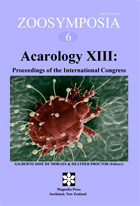Abstract
The coconut mite, Aceria guerreronis Keifer (Eriophyidae), has invaded and caused significant problems to most of the coconut plantations in southern India. Several factors appear favorable for the invasion of the mite, especially continuous availability of young fruits suitable for attack and optimum temperature most of the year. This study was conducted to evaluate details of the morphology of the immature stages and the development of A. guerreronis on coconut. It was conducted in a laboratory at 28 ± 2°C and 80% RH. The eggs were small (66 ± 4 and 41 ± 2ìm for long and short axes), and a single female laid an average of 66 ± 4 eggs during 15 days of oviposition period. Incubation period lasted 2.5–3.5 days. Hatching was completed in about 30 minutes. The larva emerged through a longitudinal slit on the surface of the egg.Almost transparent and sluggish and measuring 87 ± 12ìm long, it started feeding soon after emergence. The active period of the larva lasted 1.5–2.5 days, being followed by a quiescent period that lasted about one day. The nymph measured 176 ± 11ìm in length; the active and quiescent periods of this stage lasted 2 and 0.5–1.5 days, respectively. Adult females had an average length of 224 ± 9ìm. Eight to ten days were necessary for immature development.

